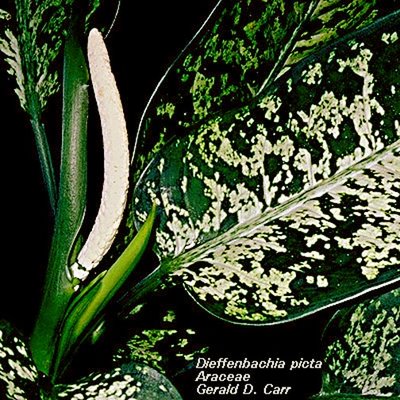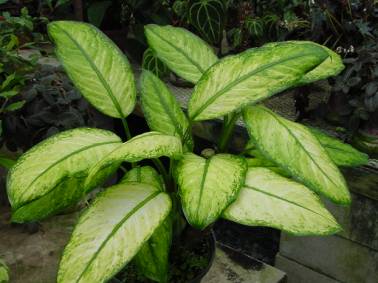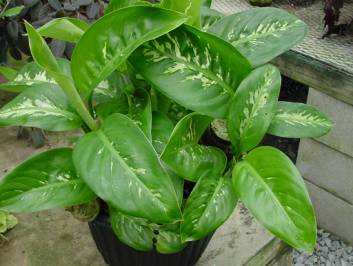Dumbcane

Common Name: Dumbcane, Mother-in-law's Tongue, Dumb Plant
With common names like Mother-in-Law’s Tongue and Dumbcane, you can be sure that this plant has an interesting story associated with it. A popular houseplant for over 150 years, the Dumbcane is native to South America where it is commonly found growing in tropical jungles, especially in Brazil. As members of the Arum family of plants (Araceae), all 30 members of the genus Diffenbachia, including the Dumbcane, count as close relatives such well-known plants as Philodendron, Pothos, Calla, Anthurium, Spathiphyllum, and Skunk Cabbage. The relationship between Dumbcane and Skunk Cabbage becomes very obvious when either plant is bruised. They both emit a skunk-like odor.
The Dumbcane, like all Arums, has an interesting blossom that consists of many small, inconspicuous flowers densely packed on a stalk called a “spadix”. The spadix is surrounded by a showy “spathe”, which is a modified leaf or bract. Dumbcane can get quite tall. Their rarely branching stems look like canes and can reach heights of over 10 feet. As they increase in size it is quite natural for their large green, white, and yellow-blotched leaves to be lost from the lower portions of the plant, leaving just exposed canes.
Undoubtedly the most intriguing characteristic of the Dumbcane relates to its common names. It has been known for over a century that the plant contains crystals of calcium oxalate, and if any part of it is eaten a sudden burning irritation and paralysis of the mouth, tongue, and lips will result. This usually prevents a person from talking for a while, which has led to the amusing common names. The ingestion of this plant, however, can have some serious consequences such as vomiting, diarrhea, and intense salivation. Death has been reported to occur when tissues at the back of the tongue and throat swell and block air passage.
In 1963 it was discovered that specialized cells called idioblasts within the Dumbcane could “shoot” double-pointed, sharp, needle-like crystals of calcium oxalate much like darts from a microscopic blowgun. These crystals, called raphides, are forcibly ejected from the idioblasts after the tips of these cells are broken off as a result of tissue damage such as from chewing. These crystals readily penetrate the soft tissues all along the digestive tract of an animal. With the aid of an electron microscope, the presence of barbs along the length of the raphides has been demonstrated. They probably prevent the raphides from being readily dislodged from the soft animal tissues once penetration has occurred. The only effective way to rid the mouth of the crystals other than letting nature take its course is to rinse the mouth with vinegar to dissolve the imbedded crystals. The rinse should not be swallowed. The raphides also have 2 grooves running down their sides, making it possible for a proteolytic enzyme in Dumbcane to penetrate the mouth and throat tissues. The enzyme is very similar to those found in scorpion and snake venoms, and accounts at least in part for the localized paralysis suffered by animals ingesting this plant.
As bad as all this sounds, it is fortunate that the raphides remain largely undissolved during their passage through the digestive tract. If these crystals of calcium oxalate were to dissolve internally, the resulting oxalic acid would create an imbalance of blood minerals and a plugging of kidney tubules with often fatal results.
The adaptive value of the idioblasts and their raphides to the Dumbcane is twofold. The plant “disposes” of potentially toxic excess oxalic acid that accumulates in the plant’s tissues by forming insoluble calcium oxalate crystals (raphides). These crystals protect the plant from herbivores (plant eating animals). No animal will have a second helping of Dumbcane.
Through hybridization and natural mutation, many fancy-leaved Dumbcanes have been developed and released into the nursery trade. As a result, there are a number of cultivated varieties with all sorts of leaf color patterns. One of the more famous is ‘Rudolph Roehrs’, developed in New Jersey from a striking chartreuse, ivory, and green-leaved mutant in 1937.
Pictures of Dumbcane








0 Comments:
Post a Comment
<< Home